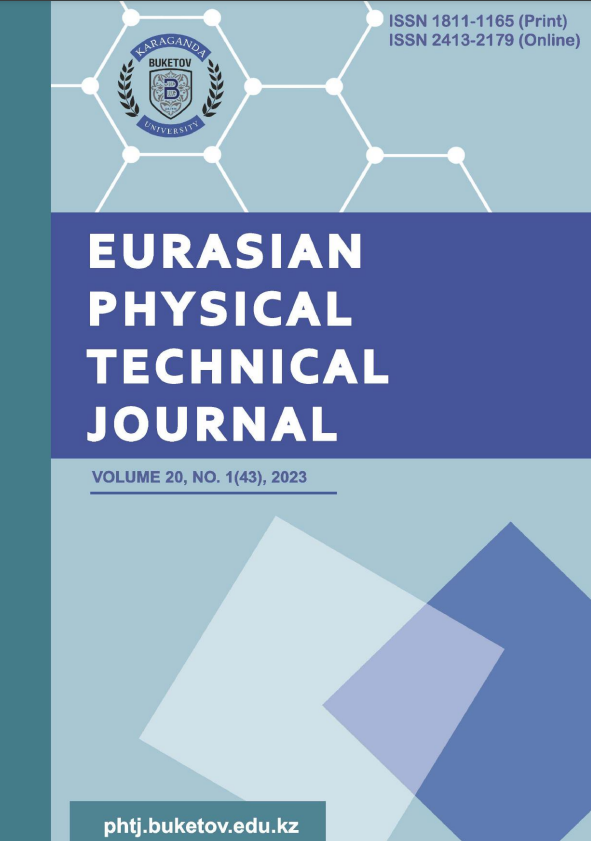Study of the influence of radiation-induced damage accumulation during the interaction of heavy Xe22+ ions on changes in the thermophysical parameters of zirconia ceramics
DOI:
https://doi.org/10.31489/2023No1/5-11Keywords:
zirconia ceramics, radiation defects, thermophysical properties, radiation damage, heavy ions, dispersed nuclear fuelAbstract
The aim of this paper is to evaluate the influence of the processes of radiation-induced damage formation in the form of point defects, dislocations and vacancies, as well as their accumulation and the formation of locally disordered regions in the near-surface layer of zirconia ceramics under irradiation with heavy Xe22+ ions with an energy of 230 MeV, on the change in the thermophysical properties of ceramics. The choice of the ion type for irradiation is due to the possibilities of modeling radiation damage processes comparable to the impact of uranium nuclei fission fragments during nuclear reactions in nuclear fuel. The choice of materials for irradiation in the form of ZrO2 ceramics is due to the prospects for their use as the main material for inert matrices of dispersed nuclear fuel for new generation reactors. This choice is due to the physicochemical, thermophysical and strength properties of ZrO2 ceramics, which are more resistant than other types of oxide ceramics. During research, it was found that the formation of isolated locally heterogeneous regions at low irradiation fluences does not lead to significant changes in the thermophysical properties of the damaged ceramic layer. However, polymorphic transformations of the t-ZrO2 → c-ZrO2 type, which occur at irradiation fluences above 1012 ion/cm2, lead to a decrease in thermal conductivity and the appearance of heat losses associated with the disruption of the phonon heat transfer mechanisms in the damaged layer.
References
Liu Y., et al. Irradiation response of Al2O3-ZrO2 ceramic composite under He ion irradiation. Journal of the European Ceramic Society. 2021, Vol. 41, No.4, pp. 2883 – 2891. doi:10.1016/j.jeurceramsoc.2020.11.042
Shukla P.P., Lawrence J. Characterization and compositional study of a ZrO2 engineering ceramic irradiated with a fibre laser beam. Optics & Laser Technology. 2011, Vol. 43, No.7, pp. 1292 – 1300. doi:10.1016/j.optlastec.2011.03.026
Liu J., et al. In-situ TEM study of irradiation-induced damage mechanisms in monoclinic-ZrO2. Acta Materialia. 2020, Vol. 199, pp. 429 – 442. doi:10.1016/j.actamat.2020.08.064
Khrustov V.R., et al. Behavior of ceramics based on Al2O3 and ZrO2 nanopowders under gamma-ray irradiation. Inorganic Materials: Applied Research. 2014, Vol. 5, No.5, pp. 482 – 487. doi:10.1134/S2075113314050098
Wang Z.G., et al. Enhanced nucleation undercooling and surface self-nanocrystallization of Al2O3-ZrO2 (Y2O3) eutectic ceramics. Journal of the European Ceramic Society. 2019, Vol. 39, No. 4. P. 1707-1711. doi:10.1016/j.jeurceramsoc.2018.12.011
Yang M., et al. Ablation behavior of SiC whisker and ZrB2 particle-filled ZrO2 sol-gel composite coating under high-intensity continuous laser irradiation. Ceramics International. 2021, Vol. 47, No.18, pp. 26327-26334. doi:10.1016/j.ceramint.2021.06.043
Ghyngazov S.А., et al. Swift heavy ion induced phase transformations in partially stabilized ZrO2. Radiation Physics and Chemistry. 2022, Vol. 192, pp. 109917. doi:10.1016/j.radphyschem.2021.109917
Van Vuuren A.J., et al. Microstructural effects of Al doping on Si3N4 irradiated with swift heavy ions. Acta Phys. Pol. A. 2019, Vol. 136, pp. 241 – 244. doi:10.12693/APhysPolA.136.241
Costantini J.M. et al. Raman spectroscopy study of damage in swift heavy ion‐irradiated ceramics. Journal of Raman Spectroscopy. 2022, Vol. 53, No.9, pp. 1614 - 1624. doi:10.1002/jrs.6414
Chauhan V., Kumar R. Phase transformation and modifications in high-k ZrO2 nanocrystalline thin films by low energy Kr5+ ion beam irradiation. Materials Chemistry and Physics. 2020, Vol. 240, pp. 122127. doi:10.1016/j.matchemphys.2019.122127
Ciszak C., et al. Raman spectra analysis of ZrO2 thermally grown on Zircaloy substrates irradiated with heavy ion: Effects of oxygen isotopic substitution. Journal of Raman Spectroscopy. 2019, Vol. 50, No.3, pp. 425 – 435. doi:10.1002/jrs.5513
Ghyngazov S., et al. Surface modification of ZrO2-3Y2O3 ceramics with continuous Ar+ ion beams. Surface and Coatings Technology. 2020, Vol. 388, pp. 125598. doi:10.1016/j.surfcoat.2020.125598
Alin M., et al. Comprehensive study of changes in the optical, structural and strength properties of ZrO2 ceramics as a result of phase transformations caused by irradiation with heavy ions . Journal of Materials Science: Materials in Electronics. 2021, Vol. 32, No.13, pp. 17810 – 17821. doi:10.1007/s10854-021-06317-3
Alin M., et al. Study of the mechanisms of the t-ZrO2→ c-ZrO2 type polymorphic transformations in ceramics as a result of irradiation with heavy Xe22+ ions. Solid State Sciences. 2022, Vol. 123, pp. 106791. doi:10.1016/j.solidstatesciences.2021.106791
Deng Z.Y., et al. Microstructure and thermal conductivity of porous ZrO2 ceramics. Acta materialia. 2007, Vol. 55, No. 11, pp. 3663 – 3669. doi:10.1016/j.actamat.2007.02.014













